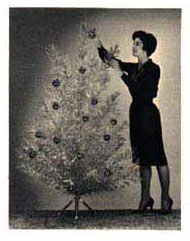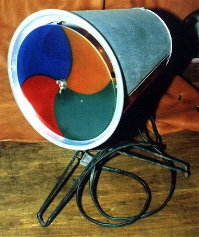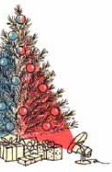

Greeley's Rancho Arcana
Part 2 of 6
1959 - 1969: "America, The Future is Now..."

Behold, the aluminum Christmas tree.
These trees are the remarkable artifacts of a time when the term 'value' was defined, developed and delivered by designers, engineers, ad men, and salespeople. Value was something managed by professionals, not stumbled over by louts, and American society warmly embraced the idea.
What was our society like back then? Well, like any question of history, it depends on who you ask, but most might agree with the impression that America was on parade and many of us were marching behind the band. Optimism was the hallmark of our public life.
We strolled to the market, the church, and the polling booth with a light and easy step. We had beaten the hell out of our enemies 15 years earlier, saved the world, and dominated the global economic system for the first time in our country's history. We also had a rapidly expanding and upwardly mobile middle class. Pretty solid reasons for holding a parade.
American know-how was always making something "better, stronger, faster," and the marketplace worked like fire to get new products into every American home. Most things came wrapped in attractive packages that mirrored the parade on Main Street: We knew what we were doing; at home, at work, at play. Nothing was beyond our reach. The future was ours. No more waiting. We were, literally, on our way to the moon, and you didn't want to be left behind. TV told us so. It was the dawn of the space-age.
This attitude came to apply to the Christmas holiday, too. Nature and her loutish trees were no longer needed in the home of tomorrow, today.
...3...2...1. Lift off... We have lift off, Houston.
~ <> ~ ~ <> ~ ~ <> ~
So who came up with the idea of aluminum Christmas trees?
Bill's Antique Christmas Light Site relates the following story: In December, 1958, a toy sales manager for an aluminum specialty firm notices a small, homemade metal tree in a display at a Ben Franklin Five and Dime store in Chicago. A clever idea, he thinks, and one that his company might make use of. He pitches the idea to the boss and gets the green light. The firm's designers get to work and by Christmas of 1959 they offer the first all-aluminum Christmas tree to the public, the "Evergleam."
An early ad from the Sears catalog touts the virtues of these wonderful trees:
"Whether you decorate with blue or red balls . . . or use the tree without ornaments - this exquisite tree is sure to be the talk of your neighborhood. High luster aluminum gives a dazzling brilliance. Shimmering silvery branches are swirled and tapered to a handsome realistic fullness. It's really durable . . . needles are glued and mechanically locked on. Fireproof . . . you can use it year after year."
After their debut, a few argued that they were 'crass.' Just another example of what was wrong with our society. Too commercial. Fake, like everything else being fed to us. Normal people tended to ignore these whiners. They probably couldn't afford to buy anything nice.
No matter one's opinion, aluminum Christmas trees were quite the example of efficiency, design, and durability.
Bill's website describes them thus:
"[The trees] had a sliver painted wooden trunk with a multitude of holes drilled in it at increasing angles, so that when each of the hand-made branches of the same size was inserted into them, they would perch upwards, forming the traditional tree shape. Equipped with a simple aluminum tripod style stand, the trees were easy to set up. Some models featured a rotating stand. Some had music boxes in the stand. ... All of the branches were identical, so assembly for the consumer was a breeze."
Branches. Trunk. Base. Simple. As you may guess, the branches of the tree were the most remarkable feature. Each 'branch' was made with a frilly streamer of polished aluminum wrapped around it corkscrew fashion and then fluffed out by hand. The more expensive trees had 'pom-pom' ends carefully crafted to give more body to the tree. When properly lighted, each frill (or 'needle') functioned like a mirror.
Imagine a mirror-ball. Good. Now imagine a tree-shaped mirror-ball and you're just beginning to grasp what these trees really look like. Photos don't do justice. They must be seen to be believed.
Properly stored and cared for, these trees could be expected to last a lifetime, saving one considerable time, money and effort. No more digging through ratty-looking trees in the supermarket parking lot at night. No pine needles or sap on the car or carpet. No water in the base to spill or leak. Decoration needs; minimal. Nothing to chop up and throw out in January, February, or July. And if you missed the smell of a real tree, you could buy a spritzer of pine scent that would make your home smell just like an old car with torn seats.
~ <> ~ ~ <> ~ ~ <> ~
A new path was opening up, leading right to that hallowed corner of America's living rooms where the old tree used to go. The rotating, symmetrically perfect aluminum tree had all the marks of becoming a modern holiday icon for the space-age. Big "P" potential here, Mr. Jones.
However, there was the problem of lighting such a tree. All people, even George Jetson, still want lights in their trees. Otherwise, it's not a Christmas tree. Gotta have lights.
A rotating tree presents obvious challenges, but running electric lights through any tree made primarily of metal could be ... problematic, an insurance underwriter might say. Liability could be, um ... an issue.
A little creative thinking solved both these challenges. Take it away, Mr. Serling...
 The year - 1959. It is night. Fate hangs in the air over sleepy Tijuana, Mexico.
The year - 1959. It is night. Fate hangs in the air over sleepy Tijuana, Mexico.
A freelance aluminum Christmas tree engineer is on vacation. He is relaxing downstairs in one of the many fine health clubs of this border town, admiring the talents of a fitness instructor performing acrobatic moves on a red platform. Music blares overhead in the dark. Smoke clings to the ceiling. The instructor is strategically festooned with tinsel.
Despite this soothing atmosphere, worry shadows the engineer. If he doesn't solve the tree lighting problem by November, Mr. Jones will be upset. Very upset. The engineer might lose his job. Little Suzie won't get her braces and young Johnny won't go to college. The wife really wants that new washer and dryer. If he doesn't deliver, he'll never hear the end of it. Damn.
 The engineer finishes his tequila. The smoke thickens. His gaze drifts down to the floor at the instructor's feet. Among the peanut shells and sawdust he notices a stationary spotlight with a rotating four-color lens, or 'color wheel.' This peculiar device provides exotic yet economical lighting effects which serve to promote form and hide defects.
The engineer finishes his tequila. The smoke thickens. His gaze drifts down to the floor at the instructor's feet. Among the peanut shells and sawdust he notices a stationary spotlight with a rotating four-color lens, or 'color wheel.' This peculiar device provides exotic yet economical lighting effects which serve to promote form and hide defects.
As the instructor slowly spins on her heel, inspiration strikes. Yes, he thinks. Just the thing. Works for her. Should work on the trees.
Now he can get that washer and dryer. He smiles broadly. The instructor smiles back. Another strand of tinsel falls to the floor. Fate has found its satisfaction, here, tonight ... in the Twi-
...yes, thank you Mr. Serling.

Thus the color wheel light and the rotating aluminum tree were joined maybe. Solving the lighting challenge helped secure commercial success for the makers of such trees and changed the landscape of many American living rooms. Trees of every shape, size, and color, numbering in the millions, were sold between 1959 and 1969. If you didn't have one of these, you probably knew someone who did. One of those decorate-with-blue-balls talk-of-the-neighborhood types.
Problem solved, Houston. On to the moon.
~ <> ~ ~ <> ~ ~ <> ~
So, Acme of ingenuity? Artifact of a cartoon world? Retro or Rubbish?
You decide. It's all in the eyes.
If you happen to still have one of these trees in the attic, you just may want to pay a visit to EBay. They still have 'value.'
Regarding the closing days of the era, you may find it paradoxical to consider that the space-age world of America actually ended the day we landed on the moon. Reality--grandly, and perhaps sadly--ended one of the most interesting marketing fantasies ever seen, on July 20, 1969.
This pivotal moment was followed by big changes back on the ground. For some reason, earth tones and textures became the next 'in' thing after man landed on the moon. Go figure.
![]()
On Dasher! On Dancer! On Prancer! On Vixen!
Onward now, to Part 3 of 6.
It wouldn't be Christmas without Toys!
...But, is it true that Santa only visits the good little boys and girls?
Not in my neighborhood...
![]()